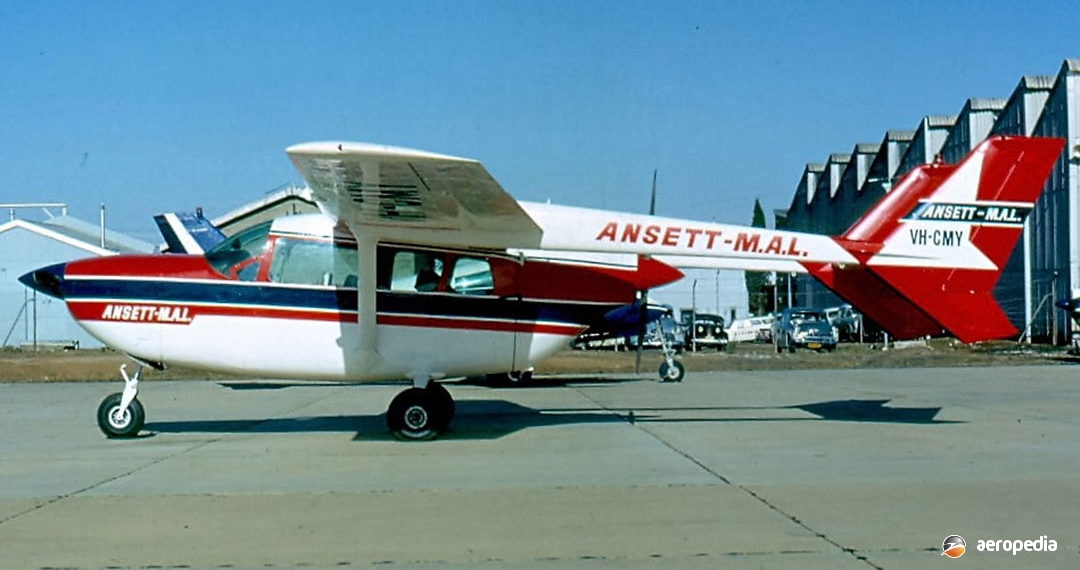Photograph:
Cessna 336 Skymaster VH-CMY (c/n 336-0005) at Bankstown, NSW (David C Eyre)
Country of origin:
United States of America
Description:
Light twin-engine cabin monoplane
Power Plant:
Two 145 kw (195 hp) Continental IO-360-A six-cylinder horizontally-opposed air-cooled engines
Specifications:
- Wingspan: 11.58 m (38 ft)
- Length: 9.02 m (29 ft 7 in)
- Height: 2.9 m (9 ft 6 in)
- Wing area: 18.67 m² (201 sq ft)
- Max speed: 294 km/h (183 mph)
- Cruising speed at 75% power at 2,134 m (7,000 ft): 278 km/h (173 mph)
- Initial rate of climb: 408 m/min (1,340 ft/min)
- Service ceiling: 5,791 m (19,000 ft)
- Range at 278 km/h (173 mph) at 2,134 m (7,000 ft): 1,127 km (745 miles)
- Max economical range with max fuel at 198 km/h (123 mph) at 3,048 m (10,000 ft): 2,116 km (1,315 miles)
- Empty weight: 1,052 kg (2,320 lb)
- Loaded weight: 1,588 kg (3,500 lb)
History:
Introduced into the Cessna range of aircraft in 1963, the Model 336 Skymaster was unique at that time amongst business light twin-engine aircraft as it had a tractor engine in the nose, a pusher engine at the rear of the cabin nacelle, and twin-booms like the Lockheed P-38 Lightning fighter of World War II. This configuration thus delivered power from both engines down the centre-line of the aircraft, improving the ease of handling of the aircraft in the engine-out situation.
In advertising the manufacturer stated that the arrangement was the result of extensive studies and, because of the configuration, the Federal Aviation Administration (FAA) in the USA issued a special centre-thrust rating for pilots qualified to fly the type. Fitted with a fixed undercarriage, the Model 336 was not particularly successful on the market and only 195 examples had been built between 1962 and 1964 when production switched to the Model 337, which was basically the Model 336 fitted with a retractable undercarriage.
The prototype of the Model 336 was flown for the first time on 28 February 1961, and certification was obtained from the FAA in the USA in May 1962. Some eight examples of this model were imported to Australia and appeared on the register, most being operated in New Guinea whilst that country was under Australian Department of Transport jurisdiction.
Four were purchased by Ansett/MAL, these being VH-CMY (c/n 336-0005 -ex VH-RLW, N1705Z), which has survived in Australia at the Queensland Air Museum, and was operated for a period as P2-CMY in New Guinea; VH-CMU (c/n 336-0084) which was damaged in a storm at Archerfield, QLD in 1980; VH-CMX (c/n 336-0111 – ex N3811U), which became VH-GKX in 1967, later becoming P2-GKX, and thereafter P2-FEG and P2-GKX with Territory Airlines; and VH-CMQ (c/n 336-0194) which crashed at Mt Hagen, PNG on 6 August 1966. STOL Air Services of Port Moresby, PNG received VH-STQ (c/n 336-0022), and Air Leanda of Port Moresby, obtained VH-RYX (c/n 336-0023).

